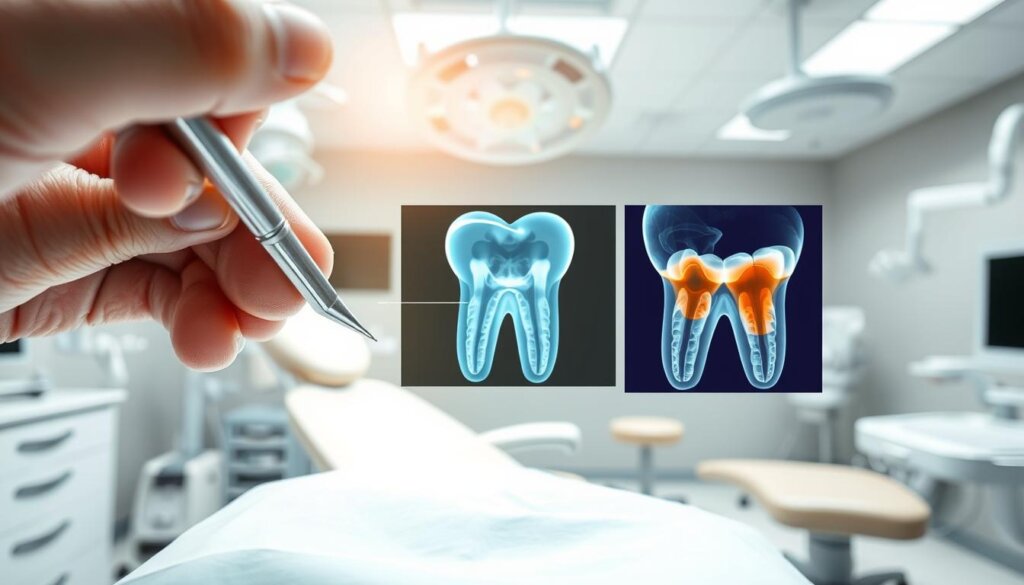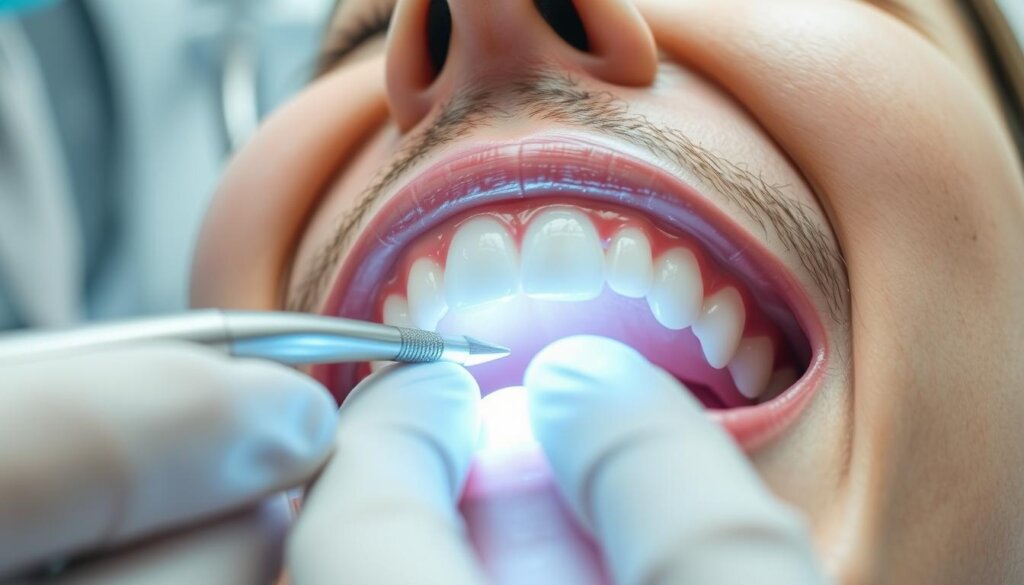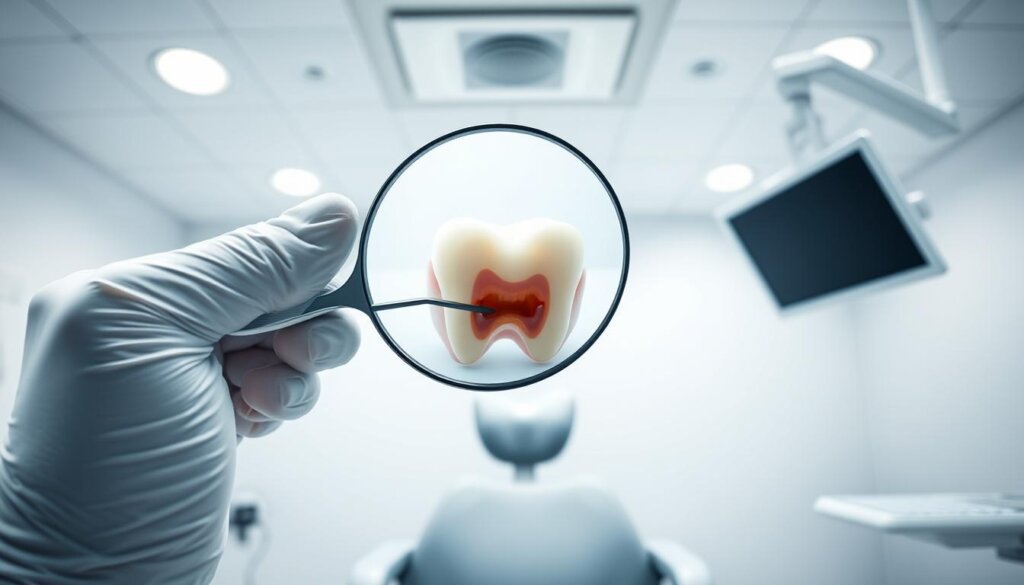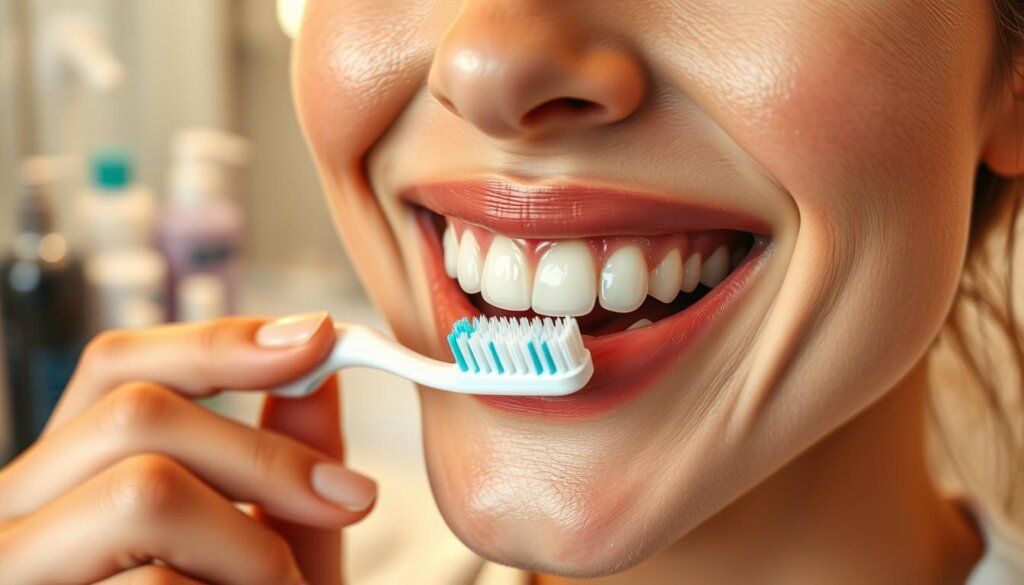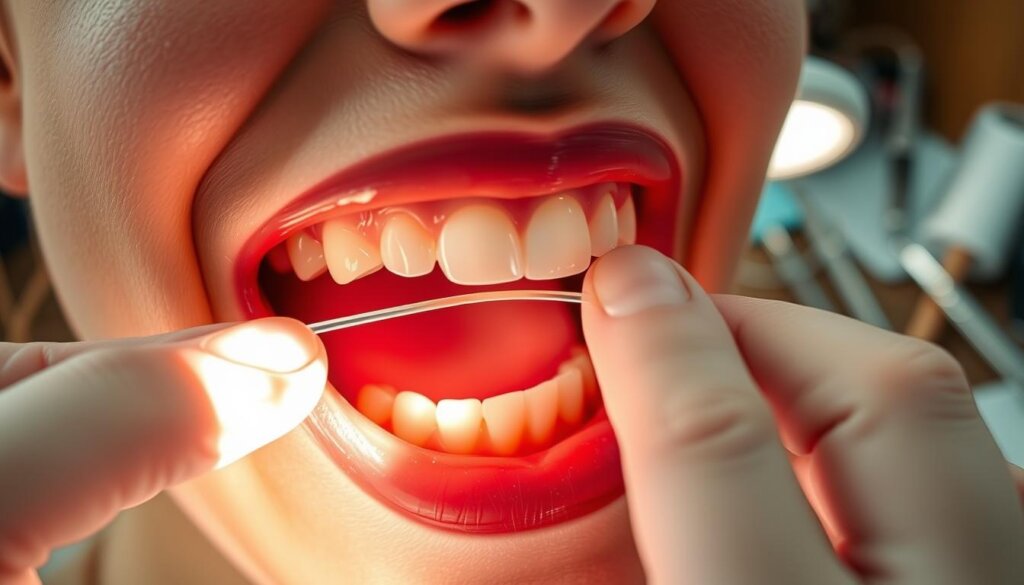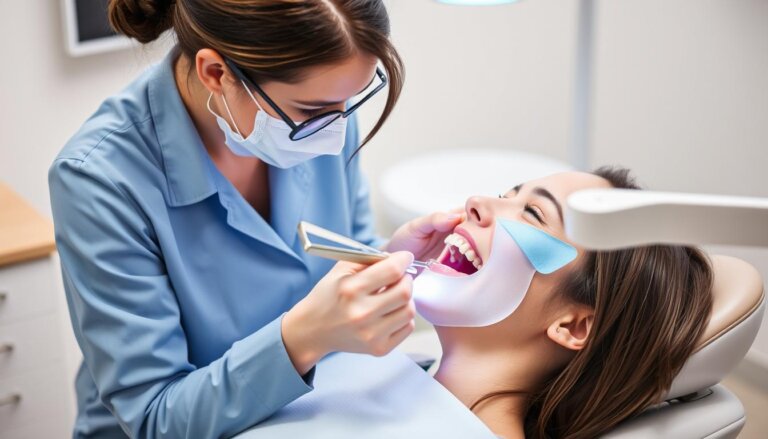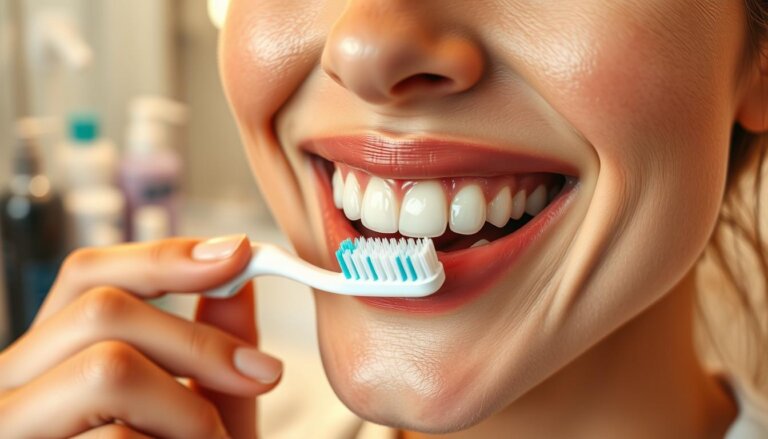What if the dentist finds a cavity during my exam?
Every year, millions of Americans get a routine dentist check-up. They don’t expect to be part of the 92% of adults aged 20 to 64 with cavities in their permanent teeth. This high number shows how common tooth decay is. So, what happens if they find a cavity during your check-up?
Finding a cavity isn’t rare during a dental check-up. It’s an important moment for your dental health. Even if you take great care of your teeth, a cavity can still be a surprise.
Even with good oral care, finding a cavity can lead to quick actions by your dentist. They use visual checks, dental explorers, and x-rays to find hidden cavities. Understanding how they find cavities helps us see why we might need treatment.
Key Takeaways
- The high prevalence of adults experiencing cavities once in their lifetime highlights the importance of routine dental visits.
- Cavity detection during a dental exam is a common yet critical step in maintaining oral health and can come as a surprise.
- Identifying tooth decay through a dentist appointment often leads to immediate plans for treatment to prevent further damage.
- Dentists employ a combination of examination techniques to ensure accurate tooth decay diagnosis.
- Understanding the methods used for cavity discovery helps to trust and validate the treatment process recommended by your dental professional.
Understanding Cavities and Their Causes
Cavities are not just occasional problems. They are a major global health issue. Knowing how they form and what causes them is key. This information helps in preventing and treating dental caries. It also makes finding cavities easier at the dentist’s office.
What is a Cavity?
A cavity, or dental caries, forms through permanent damage to a tooth’s surface. This damage creates holes. If caught early, usually at a dentist’s visit, it can be stopped and managed well.
How Do Cavities Form?
Cavities begin when mouth bacteria use leftover food sugars to make acids. These acids can wear away at tooth enamel over time. This wear is what leads to a cavity. Acid attacks on enamel can happen often, so finding cavities early is crucial.
Common Risk Factors
Many things can raise the risk of getting cavities. These range from lifestyle choices to biological factors. Here’s a list of risk factors, showing why regular dentist visits are essential.
| Risk Factor | Description | Impact on Tooth Decay |
|---|---|---|
| Poor Oral Hygiene | Inadequate brushing and flossing | Increases plaque buildup, leading to higher acid production |
| Lack of Fluoride | Insufficient fluoride in dental care routine or community water supplies | Weakens tooth enamel, making it more susceptible to decay |
| Diet High in Sugars and Acids | Frequent consumption of sugary and acidic foods and beverages | Provides fuel for bacteria, resulting in more acid production and enamel erosion |
| Eating Disorders | Conditions like anorexia and bulimia that expose teeth to stomach acids | Significantly increases risk of severe dental erosion and cavities |
Knowing about these risks helps. It boosts the success of prevention and treatment at dental visits. Being informed can greatly cut down on the effects and number of cavities.
Signs You May Have a Cavity
Finding cavities early can greatly improve how well dental treatments work. Spotting them early, especially during a cavity screening at dental exam, is key for healthy teeth. Here are some signs you might have a cavity.
Sensitivity to Hot or Cold: A sudden change in how your teeth react to hot or cold can mean your enamel is damaged. This exposes the tooth’s sensitive inside.
Pain When Chewing: If it hurts to bite or chew, you might have tooth decay. This pain can come from one tooth or several, showing you need a check-up.
Visible Holes or Stains: Seeing holes or dark spots on your teeth often means cavities. These signs, usually found during a cavity screening at dental exam, show where decay is happening.
Don’t ignore these symptoms. Going to the dentist regularly for check-ups and screenings is important. It helps catch cavities early and keeps your teeth healthy.
The Role of Dental Exams
Going to the dentist regularly is key for good mouth health. These exams check your teeth and gums closely. They also spot early signs of problems, like cavities. Knowing what to expect during an exam and the importance of regular visits is crucial for everyone.
Worried about finding a cavity at your check-up? It’s common to feel this way. But understanding the process can help you relax. Dentists look carefully for any issues that might harm your mouth health. This includes decay which can cause cavities.
- Visual assessment of teeth and gums for any signs of decay or disease
- Review of dental and medical history to note any factors that could impact oral health
- Discussion about any current symptoms or concerns, such as sensitivity or pain, which could indicate a cavity
The value of these exams is huge. Catching issues early, like cavities, means easier and cheaper treatments. Regular visits let dentists keep track of your oral health. They help stop new problems from starting, which keeps you healthy overall.
Understanding what happens if issues like cavities are found eases your mind. It helps you feel okay with going for regular dental exams.
Diagnostic Tools Used in Exams
In dentistry, having the right diagnostic tools is key for finding problems like cavities. Knowing how these tools work shows why we need regular dental check-ups.
At a cavity screening, dentists use different methods to carefully check your teeth. A main tool is X-rays. X-rays show decay hidden between teeth or under fillings. They also spot bone loss from gum disease.
Visual examination is also crucial in checking for cavities. Intraoral cameras let dentists see your teeth up close. This helps find decay or damage. Dental explorers, used with cameras, check for enamel softening, showing possible cavities.
Using cavity detection techniques helps catch cavities early. This means faster and better treatment plans. Early screening is essential for preventing more tooth problems later.
Dentists use advanced tools for more precise exams and treatments. This keeps your teeth health better for longer. Getting regular check-ups with these tools is important for good oral health.
Immediate Steps After Cavity Detection
After finding out you have tooth decay at a dentist appointment, it’s key to move quickly. Quick action helps stop more damage. You and your dentist will chat about how to fix the cavities and when.
Your first talk after learning about the cavity will explore ways to treat it. Treatments might be simple fillings or something more like crowns or root canals. Your dentist’s advice will fit your specific dental health needs.
- Discussing Treatment Options
- Fillings – for minor to moderate decay
- Crowns – recommended for extensive decay
- Root canals – necessary if the decay reaches the tooth’s nerve
- Understanding Your Treatment Timeline
- Immediate treatment for acute cases
- Scheduled procedures for non-urgent decay
- Follow-ups for treatment efficacy and further preventive measures
Knowing how long treatment takes after a tooth decay diagnosis at dentist appointment is vital. The process might be quick or take a few visits, based on decay severity and treatment type. Understanding your treatment plan helps you prepare and eases any worry about dental visits.
Treatment Options for Cavities
When you go for a dental check-up and find you have cavities, you’re given many treatment choices. Advanced dental practices and technology offer ways to fix your teeth and keep them healthy.
For a new cavity, fillings are often used. The decayed part of the tooth is removed and filled with materials like composite resins, gold, or porcelain. These materials not only last a long time but also look good. For more on fillings, check out this guide on composite fillings.
Crowns are used when the damage is worse. A crown covers the tooth, protecting and supporting it. It usually takes two visits to get a crown: one to prepare the tooth and make molds, and another to place the final crown.
For serious decay that reaches the tooth’s nerve, root canals are done. This treatment removes the damaged part inside the tooth and seals it. Even if it sounds scary, new methods make it comfortable, saving the tooth and stopping pain.
Each cavity treatment option varies in considerations, cost, and suitability. A dentist can help figure out the best choice for you. Regular dental check-ups can spot cavities early, making treatments like fillings or crowns simpler and less extensive.
Pain Management During Treatments
Handling pain during dental treatments is very important. This is especially true for procedures like filling cavities. Dentists work hard to make sure their patients are comfortable. They use special methods to ease pain after finding cavities.
Local anesthesia is a key tool. It numbs the problem area, so patients feel no pain during the procedure. Dentists also suggest using medicine from the store for any pain after the treatment. This approach helps manage pain well and aids in a smooth recovery.
Here’s a closer look at the pain relief methods dentists often recommend:
| Method | Type | Description | Duration of Effect |
|---|---|---|---|
| Local Anesthesia | Immediate | Numbing medication applied directly to the area of the cavity. | Several hours |
| OTC Pain Relievers | Post-Treatment | Medications such as ibuprofen or acetaminophen to reduce inflammation and pain. | 4-6 hours per dose |
Avoiding cavities is still the best approach. Going to the dentist regularly can help find cavities early. This way, you can get treated quickly and avoid more serious procedures.
Smiles After Treatment: What to Expect
After fixing cavities, taking care of your teeth is key. You’ll need to follow certain steps for a quick and healthy recovery. It’s important to know how long recovery could take and what care you should follow.
Recovery time changes based on your treatment. Most folks can get back to their day quickly, but some may feel sore or sensitive for a bit. It’s crucial to look after your teeth after treatment to avoid any problems.
Keeping up with good tooth care after your treatment helps a lot. This keeps the fixed spot healthy and stops new issues.
Follow-Up Care:
- Regular dental check-ups
- Consistent cleaning appointments
- Immediate consultation if experiencing unusual symptoms
Maintaining Oral Hygiene:
- Brush twice daily with fluoride toothpaste.
- Floss daily to remove plaque from between teeth and under the gum line.
- Avoid sugary and acidic foods that can worsen tooth decay.
This is how you should care for your teeth after a cavity to stay healthy:
| Activity | Frequency | Purpose |
|---|---|---|
| Brushing teeth | Twice daily | Removes plaque and prevents decay |
| Flossing | Daily | Cleans hard-to-reach areas between teeth |
| Professional Cleanings | Every 6 months | Prevents periodontal disease and updates on dental health |
By following these steps, you’ll not only heal faster but also strengthen your teeth against future cavities and other dental problems.
Preventing Future Cavities
In the fight against oral health issues, knowing how to stop cavities is key. Good oral hygiene and smart food choices really help cut down on cavities.
Brushing well is super important for healthy teeth. Using fluoride toothpaste twice a day, flossing every day, and seeing your dentist often are main ways to keep your teeth healthy. Plus, eating less sugary and acidic foods is good for your teeth too.
| Dental Practice | Recommended Frequency | Benefits |
|---|---|---|
| Brushing with fluoride toothpaste | Twice daily | Reduces plaque build-up and fortifies tooth enamel |
| Flossing | Daily | Removes food particles and plaque between teeth |
| Dental check-ups | Every 6 months | Early detection and treatment of dental issues |
| Limiting sugary foods | As minimal as possible | Decreases risk of cavities and enhances overall health |
Staying ahead is the best way to avoid cavities. Keeping up with dental visits and being careful about what you eat makes a big difference. This way, you can keep your teeth strong and avoid future dental troubles.
Alternative Treatments and Options
When it comes to oral health, thinking outside the box can really help prevent dental problems. Looking into options like fluoride treatments and dental sealants can make a big difference in stopping cavities.
Fluoride Treatments Explained
Fluoride treatments are key for keeping teeth healthy. They put important minerals back on the tooth’s surface. These minerals help fight off the germs that wear down tooth enamel.
Doctors often suggest these treatments during check-ups. They’re really good at stopping tooth decay early, saving you from bigger dental work.
Sealants and Their Benefits
Dental sealants are another great way to fight cavities. They’re painted onto the chewing parts of your back teeth. The sealants fill in the tiny grooves, stopping food and germs from getting stuck.
Once they harden, they act like a safety shield. This helps keep plaque away and stops cavities before they start.
- Provides a physical barrier against food and bacteria
- Significantly reduces the risk of tooth decay
- Especially effective in children and teenagers but beneficial for adults as well
When to Seek Second Opinions
Having trust in your dental care is vital, especially after finding a cavity at a check-up. Sometimes, what your dentist finds might make you think about getting a second opinion on dental diagnoses. This part explains why and how you should seek another expert’s advice.
Sometimes, you may have doubts about what your dentist says or suggests. It’s important to pay attention to these doubts. Getting a second opinion is a smart way to make sure you’re getting the best care.
- Consistency in Diagnosis: If a cavity find at your check-up surprised you, a second opinion can help. It checks if the first dentist’s finding matches up with what’s normally done.
- Complexity of Treatment: For big dental procedures like root canals, getting another opinion is smart. It reassures you that the suggested treatment is the right choice.
- Exploration of Alternatives: A different dentist might suggest other treatments. These could work just as well but be simpler or cheaper.
When you seek a second opinion, it’s key to be clear and open. Share your dental records and tell them your worries. Pick a dentist who is respected in the field and knows a lot about your issue.
A second opinion is good for many reasons. It confirms your original dentist’s diagnosis and plan. And, it gives you more information on what you can do, helping you make the best choice for your mouth’s health.
Managing Anxiety About Dental Visits
Many people delay or skip dentist appointments because they’re scared. Finding out why you’re scared is the first step to overcoming dentist fears. This way, you can get the care you need without waiting.
Common Dental Anxiety Triggers
- Fear of pain, often stemming from previous dental experiences
- Negative memories associated with smells or sounds typical of dental clinics
- Anxiety about invasive procedures or the potential for bad news regarding dental health
Tips for Easing Dental Fears
To deal with dentist fears, try both mind tricks and practical ways to feel safer:
- Choose a dentist known for compassionate care and good patient communication.
- Inform the dentist about your fears; a good practitioner will adopt a reassuring, patient-centric approach.
- Use relaxation techniques such as deep breathing or listening to calming music during appointments.
- Request information on the latest pain management options, as advancements in this area continue to enhance patient comfort.
Clinics offer cool perks to help you relax and not think about being scared. Knowing about these can help lessen your fear.
| Technique | Description | Benefits |
|---|---|---|
| Virtual Reality (VR) | Patients wear VR headsets to view calming scenes during treatment. | Distraction from noise and reduces perceived treatment time. |
| Sedation Dentistry | Use of medications to help patients relax during dental procedures. | Alleviates anxiety, making procedures feel quicker and more comfortable. |
| Aromatherapy | Use of essential oils to create a calming atmosphere. | Reduces stress and anxiety through soothing scents. |
This broad approach to managing dental fear helps patients relax. It helps ensure patients get needed care without too much stress.
Aftercare Following Cavity Treatment
After your dentist fixes your cavity, it’s essential to take care of your tooth. Know the steps for post-treatment dental care to help heal. Doing so also lessens the chance of more problems.
Foods to Avoid Immediately
What you eat right after getting a filling, crown, or root canal matters a lot. Some foods can cause harm:
- Chewy foods such as caramel, which can dislodge new fillings or crowns
- Hard foods like nuts, which might crack or chip the dental work
- Extremely hot or cold beverages that can trigger sensitivity in the treated area
Recommended Oral Care Practices
Preventing issues and healing well should be your main goal after dental work. Be gentle when cleaning your teeth:
- Brush gently around the treated tooth to avoid disturbing the dental work
- Floss carefully to prevent pulling on any temporary fillings or crowns
- Use antiseptic mouthwash if recommended by your dentist, to reduce bacterial buildup and promote healing
Using these post-treatment dental care tips will make your healing better. If discomfort or signs of infection last, see your dentist fast.
| Issue | Immediate Action | Long-Term Prevention |
|---|---|---|
| New sensitivity or pain | Use recommended pain relievers; avoid certain foods | Regular check-ups, proper hygiene |
| Loose filling or crown | Contact your dentist | Correct brushing and flossing techniques |
| Signs of infection (swelling, excessive pain) | Seek dental advice | Use antiseptic mouthwash as recommended |
Sticking to this advice helps make sure you heal well from cavity treatment. Always listen to your dentist’s advice for your specific case.
Frequently Asked Questions
In this section, we’ll answer some top cavity FAQs. Our goal is to boost your understanding of dental cavities. Every question echoes a major worry that lots of patients have.
Cavities are a big health problem worldwide. Kids, teens, and older folks get them a lot. But anyone, even babies, can have cavities.
Can Cavities Heal on Their Own?
A lot of people think cavities can fix themselves. But actually, once a tooth starts to decay, it can’t heal by itself. You definitely need a dentist to stop the decay and fix the tooth.
If you’re curious about cavities or want more info, talk to your dentist. They can give you advice that fits your needs.
Conclusion: Taking Charge of Your Dental Health
In today’s world, taking care of your teeth is a big deal. It’s not just something you do; it’s a promise to yourself. Knowing all about cavities helps you make smart choices for your teeth. It’s key to stopping dental problems before they start.
With this knowledge, you’ll know how to keep your mouth healthy. And you’ll choose what’s best for your dental health. These choices will help meet your health goals.
Empowering Yourself with Knowledge
To care for your teeth well, you need to learn a lot. This means knowing how cavities come about and how to prevent them. Everyone, from patients to dentists, should know the latest in dental care.
This way, you can follow the best steps to keep your teeth healthy. Knowing this lets you make the right choices for your smile.
Building a Healthier Smile for Life
Creating a lasting, healthy smile is a journey. It mixes good habits with visits to the dentist. Work closely with your dentist and keep up with your dental routine for lifelong healthy smiles.
Our dental health choices affect our smiles and overall health. Choosing wisely today matters for a lifetime.

